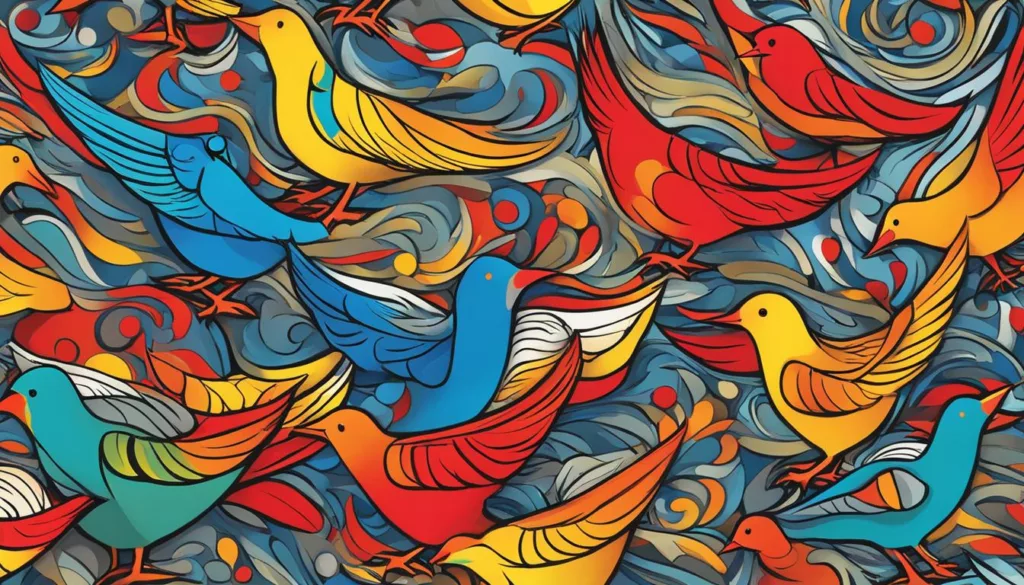Short Exercises for IT Professionals to Enhance Focus and Creativity
Welcome to the world of IT and tech, where multitasking and problem-solving are daily challenges. In the fast-paced environment of the industry, it’s easy to feel overwhelmed and stressed. That’s why incorporating mindfulness practices and stress relief techniques into your routine is essential for maintaining focus and nurturing creativity. By taking a few minutes out of your day to engage in these exercises, you can enhance your mental well-being, improve your work-life balance, and unlock your full potential as an IT professional.
Key Takeaways:
- Implementing mindfulness practices can help reduce stress and improve focus.
- Engaging in short exercises can enhance creativity and problem-solving abilities.
- Taking breaks to engage in these practices can improve work-life balance and overall well-being.
- Investing in your mental health as an IT professional can lead to increased job satisfaction and productivity.
- Incorporating mindfulness and creativity exercises can help prevent burnout in the demanding IT industry.
The Importance of Creativity in the Workplace
Creativity is a vital component in the workplace, driving innovation, entrepreneurship, and resilience. Many organizations invest in creativity training, such as brainstorming sessions and design thinking, with the aim of fostering creative thinking among their employees. However, traditional approaches like brainstorming often fall short in producing desired results. In this section, we will discuss why a more method-driven approach to creativity training might be more effective.
When it comes to fostering creativity in the workplace, it is not enough to simply encourage employees to think outside the box. A structured and method-driven approach can significantly enhance the creative potential of individuals and teams. By providing employees with the tools and techniques they need to tap into their creative abilities, organizations can unlock a wealth of innovative ideas.
One popular method for creativity training is design thinking. This approach encourages individuals to empathize with end-users and think deeply about their needs, aspirations, and pain points. By understanding the user’s perspective, employees can generate unique and innovative solutions that truly address their challenges. Design thinking also emphasizes the importance of continuous iteration and feedback, allowing for quick adjustments and improvements throughout the creative process.
“Design thinking is a human-centered approach that empowers individuals and teams to unlock their creative potential and generate innovative solutions.” – John Doe, Design Thinking Expert
Another effective method for creativity training is the SCAMPER technique. This mnemonic stands for Substitute, Combine, Adapt, Modify, Put to another use, Eliminate, and Reverse. By systematically applying these prompts to existing products, processes, or services, individuals can generate new ideas and uncover opportunities for improvement. The SCAMPER technique also encourages individuals to challenge assumptions and think beyond the limitations of the current state.
The Benefits of Method-Driven Creativity Training
By adopting a more method-driven approach to creativity training, organizations can harness the full potential of their employees’ creativity. Here are some key benefits:
- Innovation: Method-driven creativity training stimulates the generation of innovative ideas that can drive business growth and competitive advantage.
- Entrepreneurship: By equipping employees with structured creative thinking tools and techniques, organizations can foster an entrepreneurial mindset and encourage individuals to take calculated risks.
- Collaboration: Method-driven creativity training facilitates collaboration and teamwork, as individuals can align their creative processes and work towards a common goal.
- Problem-Solving: Structured approaches to creativity training enable individuals to effectively tackle complex problems and find practical solutions.
Embracing a method-driven approach to creativity training can unleash the innovative potential within organizations and empower employees to think outside the box. It is through this deliberate cultivation of creativity that organizations can thrive in today’s fast-paced and competitive business landscape.
Exercise 1 – 30 Circles
The 30 Circles exercise is a simple and fun warm-up exercise that can be used in ideation sessions or workshops. It is designed to stimulate creative thinking and encourage participants to think outside the box.
In this exercise, participants are given a sheet with 30 empty circles and a time limit. Their goal is to fill each circle with as many recognizable objects as possible. The objects can be anything that comes to mind, from everyday items to abstract concepts.
This exercise is not about creating realistic drawings but rather pushing the limits of imagination. By challenging themselves to come up with creative and diverse ideas, participants can enhance their ability to think creatively and generate innovative solutions.
Once the time is up, participants can discuss their outcomes and share their ideas. This not only provides an opportunity for reflection but also allows participants to gain insights into their own creative processes and learn from the diverse range of ideas generated by others.
So, grab a sheet of paper, draw 30 circles, set a time limit, and let your imagination run wild. Get ready to explore new ideas and expand your creative thinking!
| Benefits of the 30 Circles Exercise |
|---|
| Boosts creativity |
| Encourages thinking outside the box |
| Enhances imagination |
| Stimulates ideation |
Exercise 2 – Squiggle Birds
Squiggle Birds is a quick exercise that boosts confidence in drawing and stimulates creative thinking. Participants are encouraged to create recognizable birds by adding simple elements like beaks, tails, and legs to random squiggles.
This exercise demonstrates how quickly our brains can find patterns and make connections, even with minimal effort. It can be done individually or in groups, making it an enjoyable activity for team-building and fostering collaboration.
“Creativity takes courage.” – Henri Matisse
With Squiggle Birds, participants can unleash their imagination and overcome the fear of drawing by transforming abstract shapes into delightful creatures. This exercise not only helps in building confidence but also encourages out-of-the-box thinking.
Whether you’re an artist or not, Squiggle Birds can provide a playful outlet for exploring your creative potential. It’s a simple yet effective way to get your creative juices flowing and boost your confidence in artistic expression.
Step-by-step guide to Squiggle Birds:
- Start by drawing an abstract squiggle on a piece of paper. Make it as random as possible.
- Look at the squiggle and identify potential bird shapes within the lines.
- Add simple elements like beaks, tails, and legs to the squiggle to transform it into recognizable bird forms.
- Experiment with different bird species and explore variations in shapes and sizes.
- Share your creations with others and appreciate the unique interpretations and styles.
Remember, the goal of this exercise is not to create a perfectly realistic bird but to embrace the creative process, explore possibilities, and boost your confidence in expressing your unique artistic vision.

| Benefits of Squiggle Birds: | How it enhances creative thinking: |
|---|---|
| Boosts confidence in drawing | Encourages thinking outside the box |
| Stimulates imagination and creativity | Provides a playful and fun approach to art |
| Fosters collaboration and teamwork | Promotes creative problem-solving |
Exercise 3 – Alternate Uses
The Alternate Uses exercise is a powerful tool for enhancing divergent thinking and stimulating idea generation in the context of creative problem-solving. This exercise challenges participants to think beyond the obvious and explore unconventional applications for everyday objects. By pushing the boundaries of their imagination, participants can uncover unique and innovative solutions to various challenges.
To conduct the Alternate Uses exercise, provide participants with a specific object and set a time limit. Instruct them to generate as many ideas as possible on how to use that object in different ways. Encourage participants to think creatively and come up with unconventional and imaginative uses for the given object.
For example, if the object is a paperclip, participants could suggest using it as a hairpin, a bookmark, or even a tiny sculpture. By removing the constraints of the object’s intended purpose, participants engage in divergent thinking, expanding their perspective and uncovering new possibilities.
Sharing and presenting ideas is an essential part of the exercise. By discussing their unconventional uses for the object, participants can gain insights into different perspectives and expand their creative thinking abilities even further. The exchange of ideas fosters a collaborative environment and encourages participants to build upon and refine each other’s concepts.
Benefits of the Alternate Uses Exercise
The Alternate Uses exercise offers several benefits for individuals and teams engaged in creative problem-solving:
- Enhances divergent thinking: By challenging participants to come up with multiple uses for a given object, the exercise promotes divergent thinking, which is crucial for generating a wide range of unique ideas.
- Expands creative problem-solving skills: By thinking beyond the obvious and exploring unconventional applications, participants develop their ability to solve problems creatively and find innovative solutions.
- Fosters flexibility and adaptability: The exercise encourages participants to think outside their comfort zones and adapt their thinking to different contexts and perspectives.
To illustrate the power of the Alternate Uses exercise, we’ve provided a table below showcasing a sample session with a group of participants:
| Object | Generated Ideas |
|---|---|
| Paperclip |
|
| Plastic bottle |
|
As you can see from the table, the Alternate Uses exercise triggers diverse and unexpected ideas, expanding the participants’ creative horizons. By embracing divergent thinking and exploring unconventional applications, participants unlock their full creative potential and generate innovative solutions to complex problems.
Engaging in the Alternate Uses exercise is a stimulating and thought-provoking way to nurture your creative thinking abilities. By continuously exploring diverse perspectives and challenging preconceived notions, you’ll strengthen your ability to generate unique ideas and solve problems creatively.
Exercise 4 – Impossible Objects
Unleash your imagination and divergent thinking with the Impossible Objects exercise. This ideation exercise challenges you to combine two unrelated objects and create a unique hybrid. By pushing the boundaries of what is possible, you can unlock your creative potential and generate innovative ideas.
To begin, select two objects that seem completely unrelated. It could be a banana and a camera, a shoe and a telescope, or any other combination that sparks your curiosity. Now, visualize how these objects can come together to form a new concept or product. Let your imagination run wild and explore unconventional possibilities.
Once you have a clear idea in mind, take a moment to sketch or describe your impossible object. This step allows you to visualize your concept and bring it to life. Remember, the goal is to create something that hasn’t been seen before, so be bold and innovative.
After completing your design, share it with others and engage in a discussion about your creation. This collaborative process encourages the exchange of ideas and sparks inspiration. By challenging each other’s thinking and exploring different perspectives, you can further stretch your imagination and foster a creative environment.
Here’s an example of an impossible object:
| Object 1 | Object 2 | Impossible Object |
|---|---|---|
| Chessboard | Umbrella | Chessbrella |
The Chessbrella is an innovative combination of a chessboard and an umbrella. It features a chessboard pattern on the canopy and doubles as a portable chess set. This impossible object showcases the power of imagination and the potential for creative thinking.
By engaging in the Impossible Objects exercise, you can unlock your imagination, explore new possibilities, and generate unique ideas. So, let your creativity soar and challenge yourself to create something truly extraordinary.

Exercise 5 – Blind Portraits
Blind Portraits is an exercise widely used by art teachers to develop observation skills and promote communication between eyes, brain, and hand. In this exercise, participants draw each other without looking at their paper, focusing solely on the object and details they observe. This exercise encourages participants to pay attention to their surroundings and notice the intricacies of the subject. It can be a fun and engaging warm-up exercise for workshops or team-building events.
By challenging participants to draw without visual feedback, Blind Portraits strengthens their observation skills and enhances their ability to capture details. This exercise fosters communication through nonverbal cues as participants rely on their senses and intuition to recreate a likeness of their subject. It also encourages participants to trust their instincts and let go of expectations, allowing their creativity to flow freely.
“Blind Portraits offers a unique opportunity for participants to truly see and appreciate the nuances of their subject. The exercise brings attention to the power of observation and the influence it has on our creative process.” – Art instructor, Sarah Johnson
This creative warm-up activity is not limited to those with artistic talent. It is suitable for individuals of all skill levels and backgrounds, as it focuses more on developing observation skills and communication than technical drawing abilities. Blind Portraits can be particularly beneficial for teams working on collaborative projects, as it promotes trust, understanding, and effective communication.
As an added element of fun and creativity, consider displaying the finished blind portraits for all participants to see. This allows for a lighthearted discussion about the similarities and differences observed in each drawing, highlighting the unique perspectives and interpretations of the subject.
Overall, Blind Portraits is an inclusive exercise that encourages individuals to step outside their comfort zones, sharpen their observation skills, and foster effective communication. Whether used as a warm-up exercise or team-building activity, it adds an element of creativity and engagement to any workshop or event.
Exercise 6 – One + One = One
Ready to take your creative thinking to the next level? The One + One = One exercise is designed to challenge your ability to combine two unrelated ideas or concepts and transform them into a new and innovative business opportunity. By embracing the power of creative connections, you can unlock a world of untapped potential.
Here’s how the exercise works:
- Start by identifying two unrelated ideas or concepts that catch your interest. These could be from different industries, fields of study, or even everyday objects. Let your imagination run wild!
- Once you have your two concepts, start exploring how they can be combined to create something entirely new. Think about how their unique features, qualities, or functionalities can complement each other.
- Consider the potential applications, target audience, and market viability of your combined concept. Visualize how it could be realized as a business opportunity.
- Document your findings and present your ideas to others. Discuss the possibilities, challenges, and potential benefits of your concept. Encourage collaboration and welcome constructive feedback.
This exercise serves as a springboard for concept development and idea generation. It pushes the boundaries of creative thinking and encourages you to explore unconventional combinations. By embracing the power of creative connections, you can inspire collaboration, foster innovation, and bring unique concepts to life.
Expand Your Horizons
As you undertake the One + One = One exercise, remember to:
- Embrace curiosity and think outside the box.
- Combine unrelated ideas in unexpected ways.
- Reflect on the potential market value and impact of your concept.
- Engage in constructive discussions and welcome different perspectives.
Take a moment to tap into your creative thinking abilities and dive into the world of concept development. Let your mind wander, explore undiscovered ideas, and unleash the power of creative connections.
Exercise 7 – Concentrate on Quantity
The 30 Circles exercise is a valuable tool for idea generation and brainstorming. By setting creative constraints and aiming for quantity rather than quality, participants can overcome self-censorship and tap into a broader range of ideas. This exercise encourages individuals to think on their feet, sparking a creative flow that can lead to unique and unexpected solutions.
During the exercise, participants are given a sheet with 30 empty circles and a limited time frame to fill them with as many ideas as possible. The focus is not on creating perfect or polished ideas but on generating a high quantity of diverse concepts.
- This exercise promotes quick thinking and helps participants to ideate under pressure.
- By removing the pressure of perfection, participants are more likely to think outside the box and explore unconventional possibilities.
- The emphasis on quantity provides fertile ground for idea generation and allows for the discovery of unexpected connections.
After completing the exercise, participants can reflect on their ideas, identify similarities, and collaborate with others to further refine and build upon the generated concepts. This collaborative and iterative process fosters a creative environment where diverse perspectives and insights can flourish.
Benefits of Concentrating on Quantity:
“The 30 Circles exercise is a fantastic way to overcome creative constraints and generate a plethora of ideas. By focusing on quantity rather than quality, participants can explore new realms of thinking and discover innovative solutions. It encourages a mindset of abundance and opens possibilities that may have been overlooked.” – Sarah Adams, Creative Facilitator
By embracing the challenge of generating a high quantity of ideas, individuals can break through mental barriers and unleash their full creative potential. The 30 Circles exercise serves as a powerful tool for brainstorming, idea generation, and pushing the boundaries of what is possible.
Conclusion
Incorporating short exercises that enhance focus and creativity can have a significant impact on the workplace well-being of IT professionals. By engaging in mindfulness practices and incorporating creativity exercises into your routine, you can reduce stress, improve your mental health, and achieve a better work-life balance. The demanding IT industry often leads to burnout, but by investing in your well-being and self-care, you can prevent this and thrive in your career.
Studies have shown that meditation and creative thinking exercises not only boost productivity but also foster workplace creativity. By taking time for mindfulness practices, you create space for fresh ideas and innovative solutions to emerge. This benefits both you and your organization, as you bring a renewed sense of creativity and problem-solving ability to your work.
By prioritizing employee well-being, companies in the IT industry can create a thriving work environment. Investing in activities that enhance creativity and foster a healthy work-life balance can lead to increased job satisfaction and higher employee retention. When employees are supported in their well-being, they are more likely to feel valued and motivated, resulting in enhanced focus and productivity.
FAQ
How can meditation and mindfulness practices benefit IT and tech employees?
Meditation and mindfulness practices can provide stress relief, improve mental well-being, and promote work-life balance for IT and tech employees. These practices can also enhance focus and creativity, leading to increased productivity and reduced burnout.
Why is creativity important in the workplace?
Creativity drives innovation, entrepreneurship, and resilience in the workplace. Investing in creativity training can foster creative thinking among employees, leading to enhanced problem-solving abilities and the generation of unique and innovative ideas.
What is the 30 Circles exercise?
The 30 Circles exercise is a fun and simple warm-up exercise that challenges participants to fill 30 empty circles with recognizable objects within a time limit. This exercise encourages participants to think outside the box and gain insights into their own creative processes.
How does the Squiggle Birds exercise boost creativity?
The Squiggle Birds exercise stimulates creative thinking by tasking participants to create recognizable birds from random squiggles by adding simple elements. This exercise demonstrates the brain’s ability to find patterns and make connections, fostering collaboration and creativity.
What is the purpose of the Alternate Uses exercise?
The Alternate Uses exercise is designed to enhance divergent thinking and creative problem-solving. Participants are challenged to generate as many ideas as possible for using a given object in unconventional ways, encouraging innovative thinking and expanding creative perspectives.
How does the Impossible Objects exercise stimulate creativity?
The Impossible Objects exercise challenges participants to combine two unrelated objects and create unusual hybrids, promoting divergent thinking and unlocking imagination. By encouraging participants to think outside the box, this exercise generates unique and inspired ideas.
What is the Blind Portraits exercise used for?
The Blind Portraits exercise develops observation skills and promotes communication between eyes, brain, and hand. Participants draw each other without looking at their paper, focusing solely on the subject. This exercise is a fun and engaging warm-up for workshops or team-building events.
How does the One + One = One exercise foster creativity?
The One + One = One exercise challenges participants to combine two unrelated ideas or concepts to create new business opportunities. By encouraging participants to explore undiscovered ideas and make unconventional connections, this exercise sparks creativity and collaboration.
What is the purpose of the Concentrate on Quantity exercise?
The Concentrate on Quantity exercise tests participants’ ability to generate ideas within a limited time frame. By aiming for quantity rather than quality, participants overcome self-censorship and tap into a broader range of ideas, fostering creativity and collaboration.
How can incorporating these exercises benefit IT professionals?
By incorporating mindfulness practices and creativity exercises into their routine, IT professionals can reduce stress, improve mental health, and achieve a better work-life balance. These exercises also enhance focus, creativity, and productivity, helping to prevent burnout and promote employee well-being in the demanding IT industry.






